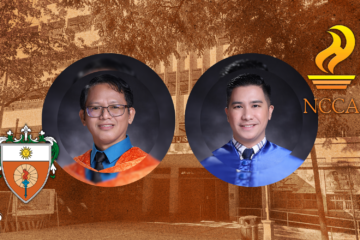
THE NEW learning setup of the UST Faculty of Arts and Letters (AB), which would allot two hours for onsite classes and one hour for asynchronous learning, elicited both praises and flak among members of the Artlets community weeks before the start of the academic year.
Under the setup, which was adopted nearly a year after the government’s lifting of the COVID-19 state of emergency, professional and general education courses would be delivered using the 2:1 onsite-to-online class ratio, with exceptions for professional courses requiring laboratory classes.
AB Secretary Asst. Prof. Louie Benedict Ignacio told The Flame late last month that the setup was meant to “maximize the learning opportunities for both onsite and online.”
READ: AB to adopt 2:1 onsite-online class hour ratio per course
While some students claim the arrangement allows “flexibility” in arranging schedules, others believe the setup is not a one-size-fits-all thing since it is not appropriate for courses requiring more face-to-face interactions.
Some Artlets find the hybrid arrangement suitable for the students’ needs, saying it will give them “more leeway” in completing tasks at their own pace.
“[D]ue to its assistance to self-study for readings, writing assignments and other time-consuming modules… We believe that the assurance of a more versatile and tailored learning schedule would prove the new class ratio to be more suitable for students and faculty members,” AB Board of Majors speaker Psalmuel Lasquite told The Flame.
Incoming Artlets Student Council (ABSC) internal vice president Kevin Christian Crisolo said the one hour dedicated to asynchronous classes would allow students to be more “flexible” in managing their time.
“It will boil down to how the professor, with the students’ collaboration, maximizes the ratio. It’s not the number of hours, but rather, it is how you maximize and make the best of the given time,” he added.
Some Artlets students and professors have expressed confidence that the setup would create an “effective balance” between maximizing technology and maintaining traditional in-person interactions.
UST Journalism Society auditor Angela Dorein Gutierrez believes the arrangement will allow students to “directly communicate” with instructors while helping students with varying paces to learn independently.
“The asynchronous class may be a way to properly recall whatever was discussed in lectures [within] the hour given, if the time was intended to be used for such purposes at least,” she said.
Calling the arrangement a “welcome change,” Creative Writing Asst. Prof. Paul Castillo said the learning mode would benefit the well-being not just of students, but also of professors.
“Not only will this lessen the burden of being bombarded with too much information in one sitting, like for the schedule of juniors and seniors that were usually three straight hours, but the course facilitators’ stamina will benefit because they won’t have to keep speaking for more extended periods,” Castillo said.
According to Philosophy Asst. Prof. Oscar Diamante, the setup will help students feel more comfortable participating during class, considering that they will be granted the chance to absorb complex lessons for a longer period of time.
“In many cases, students struggle to explain their ideas, especially when they’re asked, which takes more time. So, here, greater time is really needed,” he added.
Not effective?
However, some Artlets have reservations about the learning mode, saying it may not be effective for some subjects.
Former ABSC internal vice president Justine Claire Ello said the setup is not conducive to the quality of learning students are entitled to, especially in a “post-pandemic” setting where restrictions have eased.
“I do not find this setup suitable for our needs as students in a post-COVID-19 world. Considering that the pandemic has eased, students should have the opportunity to attend full face-to-face classes,” she said.
Incoming Communication senior Julienne Rafaela Endaya echoed the view, saying the setup would “not be effective” for her program, which requires students to be physically present in a studio or classroom for most of their activities.
“The main reason we had an online setup during the pandemic was because of the risks. Now that it has eased, I can’t see the reason why we have to continue incorporating online classes [into] our system when we already proved that onsite classes are far more efficient,” she said.
While he thinks that the 2:1 learning ratio has its advantages, Crisolo said the UST administration should have consulted students about it.
“Given the situation, this is reasonable because the one-hour asynchronous class can be beneficial, allowing time to study more and finish tasks in class. However, the university should ask for or at least have a consensus with their students because, after all, we are all for student welfare,” he said.
During the previous academic year, academic programs delivered their professional and general education courses with at least 70% and 50%, respectively, delivered onsite. Faculty members were allowed to determine the mix of their classes although a pure face-to-face learning was not permitted.
Under the new setup, most faculty members are required to deliver a third of their course hours using the asynchronous mode, which will effectively reduce the time allocated for face-to-face lectures and sessions.
Incoming Philosophy sophomore Clarence Isaac Mindo said the ratio might only be suitable to general education subjects since they have minimal influence on a student’s professional development.
“Major courses should have all the privilege to conduct full face-to-face classes as it is deemed the most effective in our program, based on experience,” he said.
Incoming English Language Studies junior Kissy Mendoza said extending the class duration could be challenging for students like her who get easily overwhelmed by learning materials.
“As a student who can be easily overwhelmed by the volume and complexity of the material being taught, I find it difficult to absorb everything within a single session. A class duration of one hour and 30 minutes is already quite intensive, so extending this to two hours could be even more overwhelming,” she said.
During the first term of the previous academic year, Artlets freshmen and sophomores were required to attend all courses that each lasted for one hour and 30 minutes.
Gutierrez said while the extended time aims to cover lessons more comprehensively, she is not convinced that the lectures would be finished within two hours.
“While it’s ideal that the lessons get to be finished per onsite session, I do have my doubts that everything could be finished within two hours since most students may take more than an hour in understanding certain lessons in their courses and may take up some time given for the discussion,” she said.
The UST Faculty of Arts and Letters will hold its online enrollment for the first term of academic year 2024-2025 from July 25 to 31. Regular classes will begin on August 9. F



